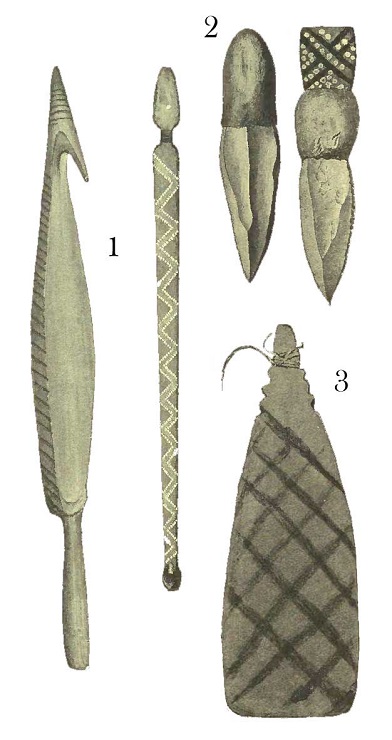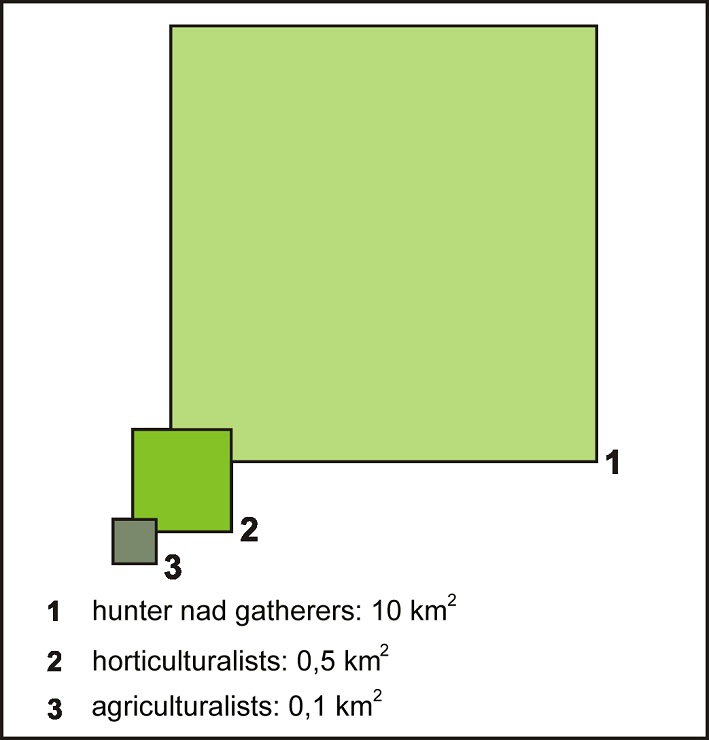|
|
|
In the 1920’s William Sollas pointed out the similarities between the archaeological finds from the European Palaeolithic and the artefact inventory of the modern hunter-gatherers of Australia. 1 – Woomera - spear-thrower, 2 - tools from stone flakes with a handle attached using resin, 3 - Bullroarer – a vibrating musical instrument used during spiritual activities. According to Sollas, 1924. . |
Hunter-gatherers, pastoralists, garden farmers and field farmers are all representative of subsistence adaptation, the most recent of several ways in which it is possible to categorise archaic societies that have already been outlined. Understood as an adaptation is a wide range of cultural traits that are bonded to the way in which people obtain their food, and also to the natural environment in which they live. The cultural specifics associated with a specific subsistence strategy then also re-emerge in the material culture as an easily recognisable reflection and therefore this categorisation can also be applicable to archaeology.
The first person to define hunting and gathering as a specific means of subsistence was the British biologist and anthropologist William Sollas. He was also the first to interconnect ethnographically documented groups of hunters and gatherers with the archaeological finds of the European Palaeolithic by defining them as being analogous.
A groundbreaking event in regard to the research of archaic societies was the “Man the Hunter” conference that took place in Chicago in 1966. The lecture given by the anthropologist Marshall Sahlins concerning the original affluent society was outstanding. Unlike such concepts as the struggle for life prevailing in the then discourse, he showed that hunter-gatherers are able to procure their livelihood relatively easily. Their overall pace of life is slow and they have only a small number of essential needs. While the necessary effort associated with human existence depends on the volume of its essential needs, archaic predatory populations are characterised by a form of harmony that industrial society has already lost. Another groundbreaking finding that was presented at the conference was documented evidence that gathering wild plants as the main food components for hunter-gatherers was of greater importance than hunting.
What also came out of the “Man the Hunter” conference was the realisation of the acute need for intensive field research taking the form of long-term observation. This was not only related to the communities of hunter-gatherers but also, generally speaking the entire spectrum of the existing forms of subsistence adaptation of traditional societies as described in the following chapters. For us too the main criterion for categorising archaic societies is their manner of subsistence.
|
|
| A sufficient amount of comparative material has enabled the detection of the differences in the size of the territory needed for the sustenance of human groups with differing economic strategies. |
Want to learn more?
- Boas, F. 1940. Race, Language, and Culture. New York: Macmillan Publishers.
- Fabian, J. 1983. Time and the Other: How Anthropology Makes Its Object. New York: Columbia University Press.
- Lee, R. B., and R. Daly. 2002. Introduction. Foragers and others. In The Cambridge encyclopaedia of hunters and gatherers, eds. R. B. Lee, and R. Daly, 1-19. Cambridge, U.K. and New York: Cambridge University Press.
- Sollas, W. J. 1924. Ancient Hunters and Their Modern Representatives. 3rd ed. New York: Macmillan.
 Archeologické 3D virtuální muzeum
Archeologické 3D virtuální muzeum

.jpg)

